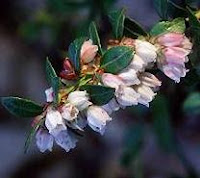 Huckleberry, common name for any of a genus of shrubs (see Heath), native to temperate North America. The pale-purple or pale-red flowers, borne in racemes, have a five-part calyx, a five-cleft tubular or bell-shaped corolla, ten stamens, and a solitary pistil. The blue to black fruit contains ten bony, seedlike nutlets. Lower surfaces of huckleberry leaves are sprinkled with resinous dots.
Huckleberry, common name for any of a genus of shrubs (see Heath), native to temperate North America. The pale-purple or pale-red flowers, borne in racemes, have a five-part calyx, a five-cleft tubular or bell-shaped corolla, ten stamens, and a solitary pistil. The blue to black fruit contains ten bony, seedlike nutlets. Lower surfaces of huckleberry leaves are sprinkled with resinous dots.Black huckleberry, native to woodlands and swamps of the northeastern United States and eastern Canada, is a shrub growing 30 to 91 cm (12 to 36 in) high, producing edible black fruits. Bear huckleberry, or buckberry, native to woodlands of the southeastern United States, is a slender shrub, less than 30 cm (12 in) high, producing unpalatable reddish-black fruits. Dangleberry, native to the eastern United States, is a low shrub producing dark-blue sweet fruits. Huckleberries are often cultivated in the United States for their foliage and fruit.
Scientific classification: Huckleberries constitute the genus Gaylussacia, of the family Ericaceae. The black huckleberry is classified as Gaylussacia baccata, the bear huckleberry as Gaylussacia ursina, and the dangleberry as Gaylussacia frondosa.



